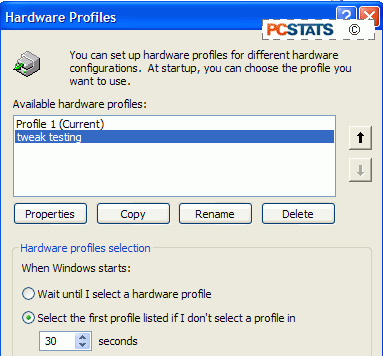6. Tweak insurance part
4: Use hardware profiles to experiment with system settings.
If you'd like to experiment with disabling various
services to increase performance, but are afraid of changing your original
configuration too drastically, consider using 'hardware profiles'.
Hardware profiles allow separate configurations of
WindowsXP to be chosen at boot up time. This feature is intended for laptop
users who will be transporting their system between various hardware and network
setups (docking stations, different networks, etc.) and allows devices attached
to the system to be activated or deactivated depending on the profile chosen.
Hardware profiles also allow services to be
selectively activated or deactivated, so it's an easy matter to create a new
hardware profile, reboot into that profile and experiment with services to your
heart's content without fear of messing up your starting configuration.
To set up Hardware Profiles on your computer;
Right click on 'my computer' and select
'properties' then choose the 'hardware' tab and hit the 'hardware profiles'
button.

If you have not used profiles before, you should
only have 'profile 1 (current)' listed in the window. This is the default
profile, or your current settings.
Now click 'copy' to create a duplicate
profile and name the new profile as you wish.
Once you have created
your profile, highlight it and hit 'properties.' Check the 'always include this
profile as an option' box.
Now reboot the PC and you will be prompted to select
a profile. Choose your new one.
You can now
configure services within your new profile. These changes will take effect only
when this profile is loaded.
7. Editing BIOS
settings
Several
tips in this guide involve making changes within your computer's BIOS (Basic
Input/Output System). The BIOS is the set of instructions your motherboard has
built into it which allow it to work with the rest of the hardware in your system.
Some BIOS
settings can be changed, and the changes stored in a small area of memory built
into the board (the CMOS) which is powered by a single coin-cell battery. The
actual BIOS itself cannot be changed (though it can be completely written over
by a newer BIOS version, see Tip 11).
To edit the
BIOS settings, most systems require you to press the DEL key while the computer
is going through its initial POST (Power On Self Test) the first screen that
appears after turning your system on. Once you are in the BIOS screen, changes
can be made to the available settings by highlighting the item, pressing ENTER
then choosing from a list - usually with the +/- keys.
Note that
these changes will not take effect until you have saved them (using the menu
option) and restarted the computer. It is possible that your motherboard's BIOS
may not contain some of the settings that we will edit below, as boards from
various manufacturers differ widely.
Again
to edit the BIOS settings:
Press DEL
several times immediately after restarting your computer. Other
manufacturers like IBM may require a different key (such as F2,
or F6), but this should be listed on the POST screen.
Select the menu and item you wish to
edit, press ENTER and choose the correct setting.
Save and exit the BIOS, which will
restart your system and put your changes into effect.
8. Editing registry settings without
restarting
Once you have made a change
to the registry in Windows XP, you generally have to reboot the computer in
order for your change to take effect. This is not actually necessary, as
with a simple set of commands, you can cause the system to reload the registry
by stopping and restarting the 'Explorer' process.
To do this:
Save and
close all open files you might be working on. For example, if you are
writing a document, you'll need to close this before reloading the registry.
Press CTRL+ALT+DEL to bring up the
task manager.
In the 'processes' tab, highlight
'explorer.exe' and click 'end process.' All windows and desktop icons will
disappear except for task manager.
Now go to
the 'file' menu in task manager and
select 'new task (run…).' Type 'explorer' into the text box. This
will relaunch explorer and load your new registry settings without
restarting.

